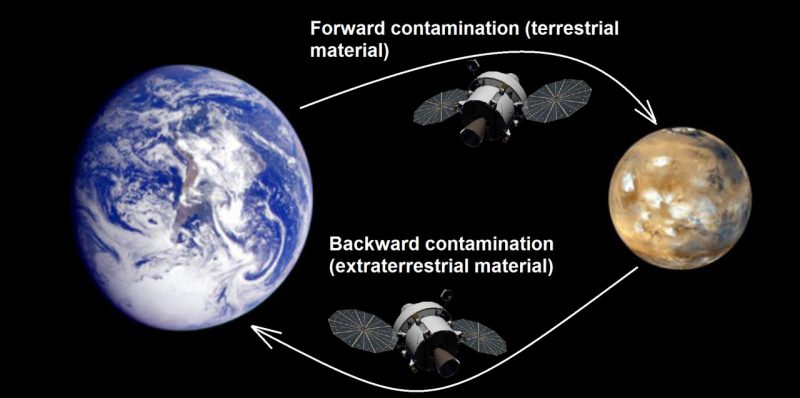- Home
- Prelims
- Mains
- Current Affairs
- Study Materials
- Test Series
Interplanetary Contamination and Extraterrestrial Life
Recently we witnessed the launch of three missions to Mars – China’s Tianwen-1 on 23 July 2020, which aims to land on the Red Planet’s surface, and the UAE’s Al Amal (Hope) on 20 July 2020, which does not involve a landing, but an orbital mission that will study the Martian atmosphere. On July 30, the US launched its Perseverance mission. It was NASA’s 10th successful Mars landing since 1975.
As ambitious space missions are proliferating, along with advances in commercial space flight, astrobiologists have expressed concerns about possible ‘interplanetary contamination’.
Such contaminations are of two types – forward contamination, meaning the transport of Earth-based microbes to other celestial bodies; and back contamination, or the transfer of extraterrestrial organisms (if they exist) into the Earth’s biosphere.

Forward contaminating Mars
In the past, space missions have established physical contact with astronomical bodies such as comets and asteroids, and crewed missions have landed on the Moon. However, since these bodies are known to be hostile to life, the possibility of their forward contamination has not been a pressing issue.
In the case of Mars, however, space missions have already discovered the possible presence of liquid water on the planet, either in the subsurface today or at some point in its past, and are now actively looking for signs of life.
Astrobiologists say that if there is a chance that Mars has life, even in its most primitive form, there is an ethical obligation on humanity to ensure that microbes from Earth do not disturb a possible Martian biosphere, allowing it to evolve in its own way.
Secondly, experts worry that Earth-based organisms could spoil the integrity of the Red Planet’s samples that rovers want to study – a highly disruptive concept for scientists who are looking for signs of native Martian life.
Back contamination
NASA also plans for a Mars sample-return mission, which would bring samples of the Red Planet back to Earth, possibly by 2031.
Scientists, however, all but rule out back contamination. The suggestion that Martian microbes (if they exist) would infect human beings–causing a catastrophe like the current pandemic– is highly unlikely, given the fact that their biochemistry would be markedly different from that on Earth.
Planetary protection
The United Nations Outer Space Treaty of 1967, which serves as a bulwark against the militarisation of space, also requires nations to worry about contamination risks. Its 110 state parties include the US, Russia, China, and India.
To ensure compliance with the Treaty, the Committee on Space Research (COSPAR) lays down a ‘planetary protection policy’ that aims to limit the number of microbes sent to other planets, as well as ensuring that alien life does not cause havoc on Earth.
According to NASA, the guidelines have had far-reaching implications on human spacecraft design, operational procedures, and overall mission structure. Both NASA and the ESA have also appointed Planetary Protection Officers.
To prevent forward contamination, space missions take care to ensure that spacecraft are sterilised. Previous Mars missions, such as NASA’s Viking landers of the 1970s, were all sterilised before being launched into space. Recently, NASA’s Perseverance mission was postponed for a second time to resolve a potential contamination issue.
In the case of back contamination, sterilisation would not be an option–as this would ruin the extraterrestrial samples. Containment would be the only option to break the chain of contact between possible alien microbes and life on Earth.









 Latest News
Latest News
 General Studies
General Studies